How Agentic Automation Helps You Build Lasting Customer Relationships
Agentforce streamlines workflows, improves efficiency, and enhances customer satisfaction. Here’s how.
What is an agent?
These AI-powered agents can take actions on marketer’s behalf, including answering simple questions to resolving complex issues — even multitasking. For example, an agent could simultaneously draft personalized email campaigns for different customer segments, schedule their delivery across various channels, and then monitor campaign performance in real time, adjusting efforts and targeting as needed. Most importantly, agents can continuously be improved through feedback, refinement, and precise grounding data. This is distinct from traditional AI and automation, which requires human input for these specific tasks.
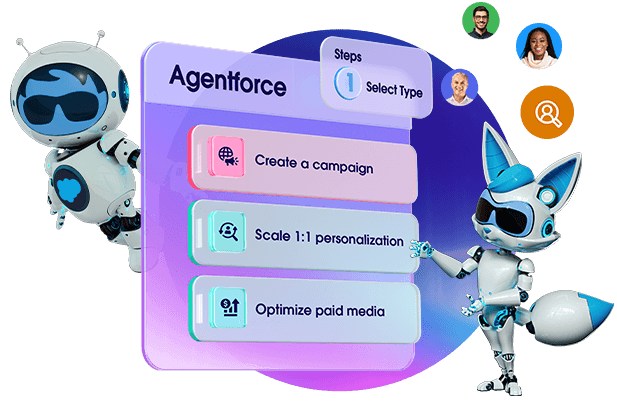
When assigned a task, an agent can access and analyze relevant data to inform decision-making, develop a comprehensive action plan to achieve the desired outcome, and then implement the action plan. This action-oriented approach requires a strong data foundation. AI thrives on solid data, so any silos greatly hinder its efficiency. A unified data foundation allows agents to have access to real-time, structured, and unstructured data, like service offerings and brand guidelines. This ensures they make informed, relevant, and accurate decisions.
To fully understand its capabilities, it’s important to recognize the five essential attributes of an agent:
- Role: This agent’s purpose is to identify optimal posting times, suggest relevant content, and track campaign performance.
- Trusted data: The agent requires access to historical social media data (past posts, engagement metrics), competitor data, audience demographics, trending topics, and brand guidelines.
- Actions: The agent needs the ability to analyze data, identify trends, schedule posts, generate content ideas, track campaign performance, and adjust strategies based on real-time data.
- Channels: The agent primarily interacts within the social media platforms themselves and integrates with the company’s marketing automation platform.
- Guardrails: And finally, the agent must operate within strict guidelines regarding data privacy, brand voice, and ethical advertising practices. It should also be equipped with safeguards to prevent the dissemination of misinformation or harmful content.
Now that we’ve identified the five attributes of our agent, let’s explore how we can deploy this agent. When it comes to consumer-facing experiences, agents interact directly with customers, powering 1-to-1 journeys and unique digital experiences across every touchpoint. This can involve providing personalized product recommendations, answering customer inquiries, or offering real-time support.
For employee-facing experiences, agents can streamline workflows and increase productivity, making it easier to use the tools they already have. Marketers can simply describe a strategy and the agent can interpret their intent and draft end-to-end campaigns. For example, complex workflows for media planning, content creation, and journey mapping can all be automated to save time and reduce spend. Agents can also provide intelligent assistance, offering relevant information and insights that employees can review, approve, and then delegate the execution of tasks to the agent. For a business to manually connect all the attributes of an agent, they would likely face significant challenges and costs. To bridge the gap between theory and practice, a unified platform simplifies this process. It allows marketers to put the agent into action – let’s see how.

Get five use cases for connecting business data and activating it across the customer lifecycle.
What do agents mean for marketers?
While agents can personalize interactions with each customer, they might be even more valuable for streamlining and automating how marketing teams work internally. But, still the question remains: What exactly does a marketer need to automate and how is that built?
First, let’s consider the automation of customer service compared to marketing. The task for the agent for customer service is relatively straightforward: Resolve the issue and satisfy the customer. The application of agents to marketing automation, however, presents a more complex challenge. Unlike agents directly interacting with customers to solve service issues, marketers often work behind the scenes, planning and executing campaigns. Traditional marketing approaches involve manually mapping out customer journeys, building campaigns, and defining decision points.
Marketers try to connect departments and work across data silos to maintain consistency and make informed decisions. This approach fails to account for the dynamic nature of customer behavior. Customers demand personalized experiences, and they want to lead their own journeys tailored to their individual needs, not be confined to predefined paths.
Agentic automation offers the intelligent solution marketers need for a more flexible and personalized approach. By understanding context and customer intent, agents can orchestrate personalized experiences that adapt to individual needs and surpass the limitations of manually created journeys. Marketers define the overall strategy, while agents handle the action, ensuring campaigns are delivered effectively and efficiently.

The agent performs the same tasks a marketer would, but with the advantage of real-time data that allows for faster execution. It provides up-to-date information, offers relevant suggestions, and assists in decision-making processes. For example, the agent may autonomously send a message to greet a customer in the moment, or in an attempt to reengage. Yet, this isn’t a linear process — the agent is intelligent, interpreting customer actions, processing data in the moment, and adjusting the journey on the fly. It’s like having a dedicated marketing assistant who constantly refines campaigns to improve customer engagement and conversion. It can even help marketers optimize paid media by autonomously identifying and pausing low-performing ads, recommending improvements, and adjusting metrics based on autogenerated goals and targets.
Additionally, agents help marketers overcome the fragmentation that often exists between departments and systems. Breaking down data silos is arguably the most important capability of agents, one that previous AI tools couldn’t address. Customers want a smooth experience, no matter how they choose to connect with a business. In fact, customers’ number one frustration is a disconnected experience. Yet, only 31% of marketers are fully satisfied with their ability to unify customer data sources. Agents serve as a central point of integration, pulling in customer data from various sources and ensuring a consistent brand experience across all touchpoints. An agent’s skillset allows customers to interact with a brand as one entity, rather than disconnected departments lacking holistic data. This could look like answering questions, qualifying leads, resolving issues, and recommending personalized products, content, or offers.
The good news is that agents don’t require perfect data. Unlike traditional systems that often require complete information or rely on broad “other” categories when data is missing, agents can still make informed decisions and deliver unique experiences for individuals even with incomplete information. For example, imagine recommending hiking gear. If a customer profile lacks their hiking experience level, a traditional system might default to generic or “beginner” recommendations. In contrast, an agent could infer their experience level based on other data, such as their purchase history of trail running shoes and their engagement with advanced hiking content, enabling more personalized gear recommendations. This flexibility allows for more personalized interactions and better accommodates the nuances of individual situations.
Simply put, agents are redefining the way marketers operate. They bring automation to the complex world of customer lifecycles. With agents, marketers can orchestrate sophisticated, 1-to-1 personalized journeys that adapt to each customer’s unique intent and context across the full lifecycle.
How can marketers use agentic automation across the customer lifecycle?
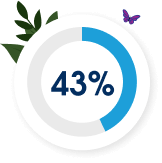
43% of marketers still take a fragmented approach to personalization.
From lead generation to customer loyalty, agents can automate end-to-end touchpoints, enhancing efficiency and improving customer satisfaction.
Here’s a look at the impact on different journey stages:
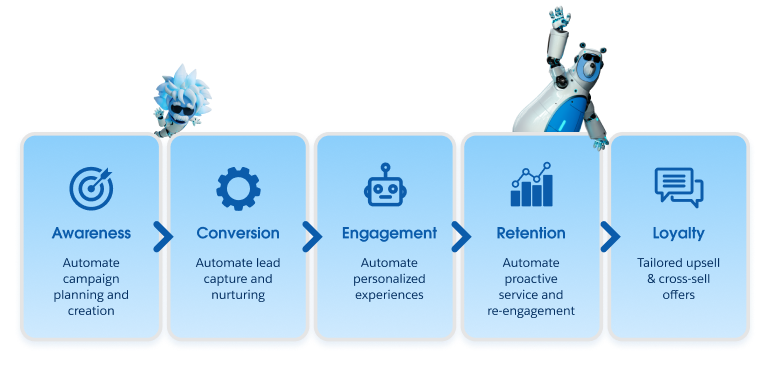
Automate campaign planning and creation
In the awareness stage, marketers are looking to progress customers who fit their target customer profile down the funnel. Agents can help with this by analyzing existing paid media campaign performance and identifying optimization opportunities. They can even create plans to improve on the key performance indicators (KPIs) defined by the marketer, including how to optimize the target audience, content, channels, and ad spend.
Agents are able to autonomously generate campaign briefs, target audience segments, personalized emails, and build automated customer journeys. These capabilities alleviate the burden of repetitive tasks for marketers, enhancing productivity and efficiency.
Automate lead capture and nurturing
As marketers look to progress customers along on their respective journey, it’s important they measure the conversion from one phase to the next. An agent can autonomously greet website visitors and offer to assist them with product or service recommendations, or suggest relevant resources to learn more. This process could include capturing the contact information needed to make the recommendations more tailored, registering the customer for a webinar, providing a relevant gated asset, or scheduling a follow-up appointment with a sales rep.
From the information collected, agents can then power intelligent lead-nurture journeys by mapping contact information, evaluating leads based on predefined scoring models, routing qualified leads to the appropriate systems and individuals, and orchestrating tailored follow-up sequences. Agents can also organize flow-driven personalized experiences based on a lead’s behavior and past interactions with the brand.
Automate personalized experiences
By delivering engaging experiences, marketers guide customers toward these desired conversions. Agents can help engage customers by providing personalized product and content recommendations based on what the customer has previously viewed, delivering tailored promotions, or orchestrating next best actions across touchpoints and channels.
Agents can also enhance marketers’ capabilities by helping to configure personalization points, decisions, and recommendations across every communication channel. Marketers can use agents to conduct A/B testing of personalization methods, including automated recommendations versus rule-based strategies, cross-channel targeting, and creative copy variants.
Automate proactive service and reengagement
Marketers know that it’s far more efficient to sell to an existing customer than acquire a new one. Fostering an ongoing relationship, even when the customer is not in market, is critical for retention and loyalty. Agents are uniquely positioned to build on the customer relationship beyond the point of purchase. With access to customer behavior data, they can proactively identify when a customer is at risk of disengaging or canceling and autonomously draft an email with reengagement discount offers or new product recommendations. Agents can also use channels like SMS or WhatsApp to provide personalized assistance with issues like product exchanges, technical support, or recalls, building trust and loyalty with proactive service.
This approach helps build a stronger relationship with the customer and increases loyalty to the brand. If a customer’s question is beyond the agent’s capabilities, they can easily escalate the conversation to a human support representative, ensuring the customer’s needs are met.

A unified marketing and service strategy can deliver more personalized customer journeys. Here’s how to build yours.
Get started with agents by building a strong data foundation
To fully embrace agentic automation, marketers need to fundamentally change the way they think about data. Traditionally, data has been stored in siloed systems, making it difficult to gain meaningful insights and create personalized customer experiences. But to effectively adopt agents, marketers need to take a more holistic approach.
Marketers must provide agents with the necessary context and data they need to execute a task. Think of an agent as a highly intelligent intern: capable of quick learning but reliant on a strong foundation of knowledge and guidance on appropriate and inappropriate actions in various situations. Providing an intern with a large volume of information, like knowledge articles, blogs, or miscellaneous notes, without proper context can hinder their ability to effectively use that knowledge. By explaining the “why” behind the information and providing clear guidance on how to apply it, you empower them to make informed decisions, identify potential issues, and ultimately deliver higher quality work. Just like providing context and clear guidance to an intern, marketers should prioritize the quality and relevance of information rather than focusing solely on the quantity of data.
By framing data as a tool to empower the agent, marketers can effectively bridge the gap between human understanding and machine intelligence. Instead of asking, “What data do I need?”, they should consider, “What information would I and the agent require to accomplish this task?” This shift in perspective involves transforming human-readable information into machine-processable data.
Unlike large language models (LLMs) that rely on vast amounts of data to generate standard responses, agents require specific knowledge to address business-specific challenges. By using retrieval augmented generation (RAG), marketers can ground the agent in relevant information, ensuring accurate and contextually appropriate outputs. To help with this, the Salesforce Platform has safety guardrails called the Trust Layer. Your prompts are grounded and enriched with your unified data through the power of Data Cloud. The output of a prompt depends on permissioned access to relevant data, and we make that possible through secure data retrieval. Furthermore, the Atlas Reasoning Engine goes through a loop of reason, act, and observe until a user goal is fulfilled.
The key to getting started with successful agent implementation lies in providing the right data, at the right time, to enable intelligent decision-making and effective action.
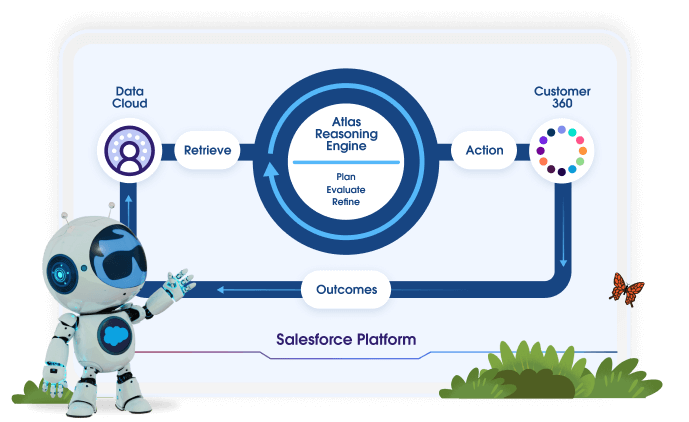
Find your next steps
The integration of an agent into marketing is a game-changing opportunity for businesses. By automating routine tasks, marketers can focus on strategic initiatives that drive growth and innovation. With agents orchestrating marketing campaigns, businesses can deploy personalized customer experiences that make each and every interaction meaningful across the entire lifecycle.
The future of marketing will be one where technology and human ingenuity work together to help businesses reach new levels of success and build stronger relationships with their customers. Businesses will rely on digital labor and an agentic layer that spans across the entire company, enabling customers to interact with agents before they interact with humans. This will increase margins and boost productivity in an unprecedented way.
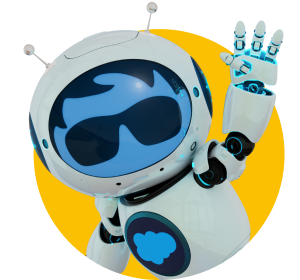
Humans with agents drive customer success together on the Salesforce platform.

5 Ways Agentforce Can Elevate Your Marketing Strategy

9 Ways AI and Agents Can Save Marketers Time, Money — and Grief
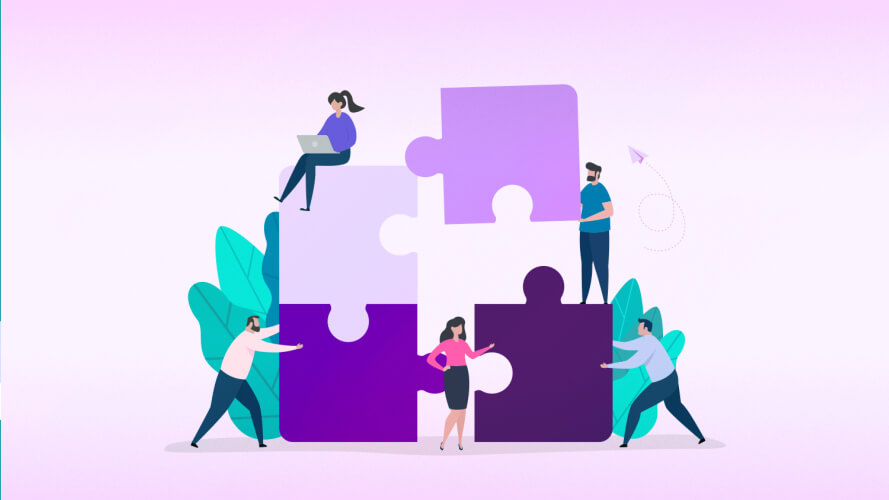
Customer-Driven Relationships: How to Build Them in Today’s Agent-Driven Era
More resources

Transform AI insights into tangible actions with Agentforce for Marketing.

Discover how AI and Agentforce drives results for marketers.



